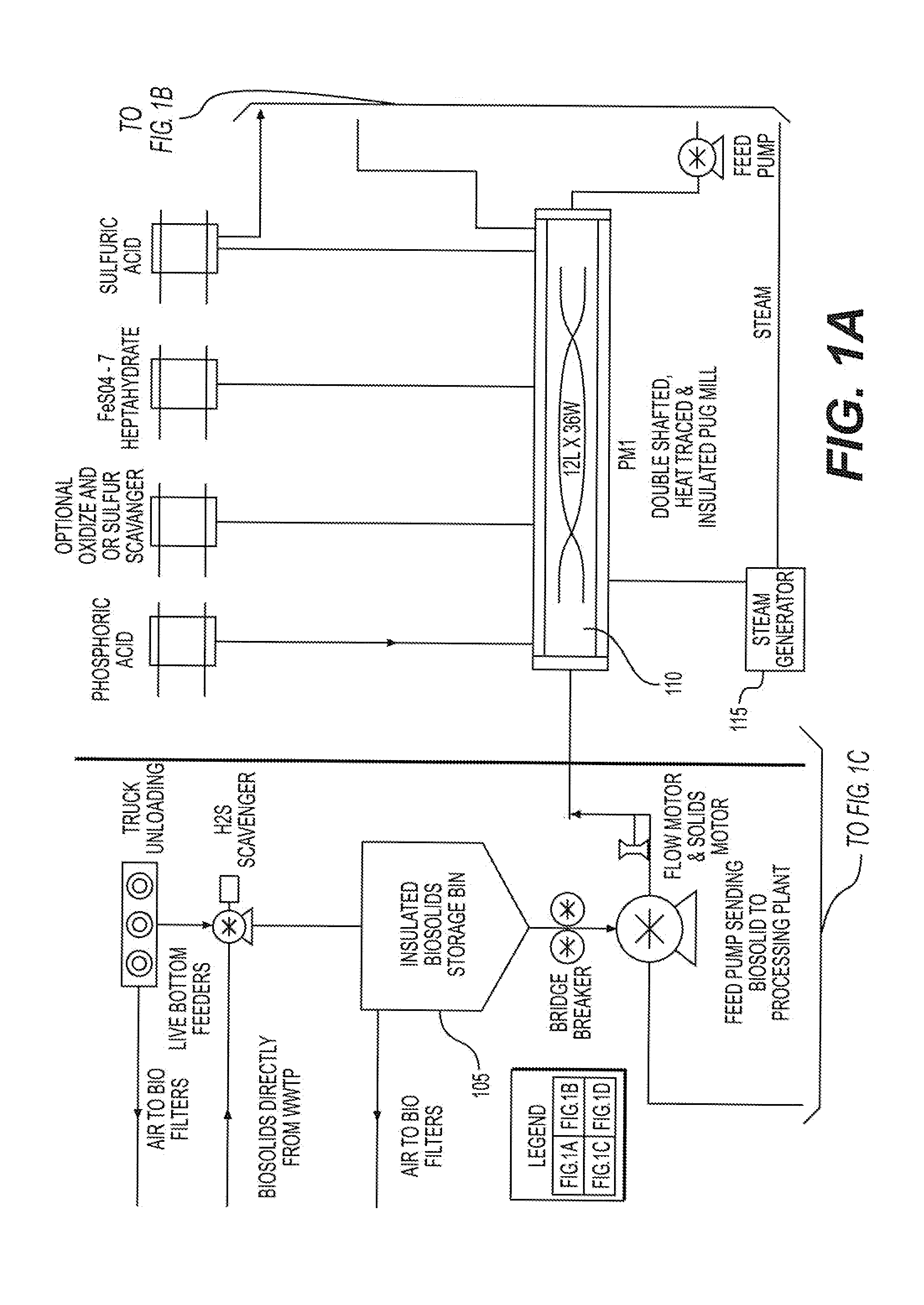The disposal of biosolids discharged from municipal
wastewater treatment plants is a serious and growing problem.
Commonly, but inadequately, biosolids are merely dewatered to the best extent possible by chemical and mechanical means.
However, the investment required for a biosolids
drying facility is very large resulting in tremendous municipal costs per dry
ton of biosolids.
Because Class B biosolids contain
pathogen indicators—and therefore potential pathogens, they are restricted in the manner by which they can be applied to animal and human crops.
If a limit for any one of these is exceeded, the biosolids cannot be applied to the land without the incorporation of significant restrictions.
Freight and application costs per unit of
nitrogen are high.
The heat-dried biosolids often have a disagreeable
odor, particularly when moist.
Also, dried
pellets have
low density and
hardness and when blended with other commercial fertilizer materials, the
pellets may segregate, and disintegrate and may not spread on the field uniformly with other more dense ingredients.
The disagreeable
odor associated with the use of biosolids, unless adequately treated, will continue to be present during further
processing of a
nitrogen rich fertilizer product, and can continue to be present in the final product.
This complicates the placement of suitable fertilizer
processing plants to locations that are not in close proximity to residential communities.
Additionally, the longer distance that biosolids must be transported adds to the cost and logistics of disposing of this
waste product.
Another
disadvantage to current biosolids-enhanced fertilizers is that bacterial action may continue when the material becomes moist, and under storage conditions, the material's temperature may rise to the point of auto-ignition.
Hence, except for special markets that value its
organic content for soil amendment or filler in blended fertilizer, there is relatively poor demand for the heat-dried biosolids product.
However, this is frequently still more economical than alternative disposal schemes.
Thus, the processes require the handling of
formaldehyde, a highly toxic lachrymator and suspected
cancer-causing agent.
Other processes require costly
process equipment and / or special conditions not readily incorporated in existing
sewage treatment facilities (see, Japanese Patent No. 58032638; French Patent No. 2,757,504).
dry.
Urea is also highly susceptible to breakdown to
ammonia by the microbes and enzymes in biosolids if they are not properly prepared, resulting in nitrogen loss and an
odor pr
oblem.
Ammonium nitrate is a strong oxidizer and can result in a potential explosion problem which has all but eliminated this fertilizer from the commercial market afte
r 2000. All of these fertilizers have
high nitrogen content, but are less than ideal for combining with biosolids absent special pro
Because of this usage, the value of these materials has been restricted to only a few dollars per
ton of product.
However, transportation costs are high in large part due to the significant
water content of the material.
Amounts of water up to fifty percent render transportation economically and geographically restricted to areas close to the source of their treatment.
The methodologies taught by this group of patents (U.S. Pat. Nos. 5,984,992; 6,159,263; 6,758,879 and 7,128,880) are plagued by problems related to the blockage of these narrow relative to their length reaction “
pipe-like” reactor configurations during operation and related to the difficulty of control of the
reaction temperature and pressure and
retention time of the mix within such
pipe-cross reactors.
The
plant practicing the manufacture of organically-enhanced
ammonium sulfate fertilizers often had to
shut down and disassemble the
pipe-cross reactor either due to blockage from biosolids buildup or from destructive over heating in such reactors such that the commonly used Teflon®
coating on the interior-reaction side of the reactor was melted and ruined.
Further, the use of the pipe-cross reactor has the distinct
disadvantage of having very short reactor retention times (usually less than twenty seconds) which is an
advantage in the manufacture of traditional fertilizers like
ammonium sulfate but is a
disadvantage when coupled to the simultaneous process of biosolids.
Such short processing time increases the probability of untreated or non-homogenous mixing as the three material inputs pass through this reactor.
Also limiting is the lack of control over the
atmospheric pressure within such pipe-cross reactors since these reactors have open-ended discharges usually directly into a granulator.
Related to but distinct from the lack of control of internal pressures, pipe-cross reactors also have little to no
temperature control over the mix passing through the reactor.
However, Robinson fails to meet the need for a novel and practical
continuous flow method of manufacturing
high nitrogen (greater than 8 wt. percent nitrogen) and biosolids-containing fertilizer products under the advantages of defined temperatures, pressures and reaction retention times. Thus, an urgent need exists for an effective, efficient, and economical process for treating biosolids.
 Login to View More
Login to View More 


